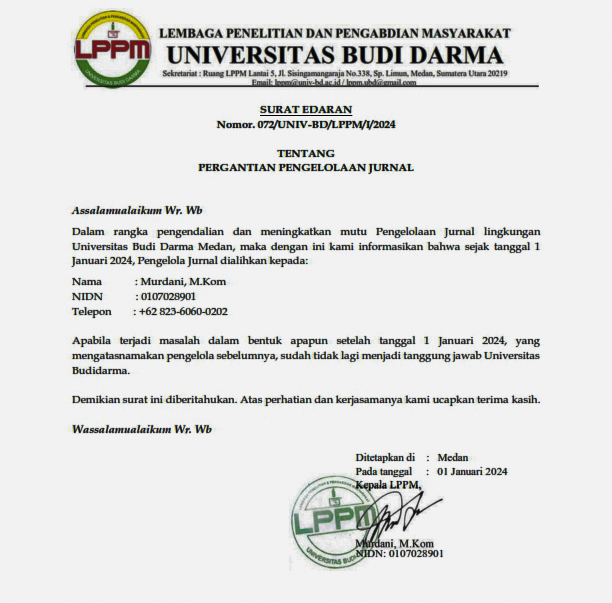Sistem Pengambilan Keputusan Penentuan Jurusan Pada Jenjang Sekolah Menengah Atas Menggunakan Model Yager
DOI:
https://doi.org/10.30865/json.v4i2.5274Keywords:
Decision Support System, Student Majoring Interests, Yager models, IntersectionAbstract
Education is very important in supporting the intelligence of each individual, from an early age it starts to recognize many things in each level of education. Knowledge and abilities continue to develop until determining interest in the right major according to the values, abilities, desires and character of each individual student. In reality, the process of determining majors, especially at the high school level, is carried out in grade X, but this process can be done when students register, for example at Dharma Praja Denpasar High School. There are assessment criteria used in the process of determining students' major interests, namely the Average Report Card Score (C1), Science Test Score (C2), Social Science Test Score (C3) and Psychological Test Score. Applying the Yager model so that the process of determining the weight of the criteria can be done with the concept of a pairwise comparison matrix, another advantage is the process of calculating the intersection of alternative values on each alternative so that it can produce suggestions for majoring interests. The study used 5 alternative students with suggestions for majoring in science and social studies. The results showed that the Yager model could provide recommendations for the best majoring options for 5 alternatives, namely alternative A1 for science majors with a value of 2.19067, while alternatives A2, A3, A4 and A5 obtained recommendations for social studies majors. Features of the web-based major determination decision support system produce the ability to manage alternative data, criteria, alternative values, majoring processes, final results and there are test features that students can do on the system, making it easier for students to make majors and schools to recapitulate the process of determining majors. The results of blackbox testing for a total of 8 scenarios show that the system functionality is running well.
References
Y. Alpian, S. W. Anggraeni, U. Wiharti, and N. M. Soleha, “Pentingnya pendidikan bagi manusia,†J. Buana Pengabdi., vol. 1, no. 1, pp. 66–72, 2019.
A. Faiz and I. Kurniawaty, “Urgensi Pendidikan Nilai di Era Globalisasi,†J. Basicedu, vol. 6, no. 3, 2022.
S. Susanti, D. A. Irawati, and R. Rismanto, “Sistem Pendukung Keputusan Penjurusan pada Siswa SMA,†J. Inform. Polinema, vol. 3, no. 4, p. 48, 2017.
S. Asmah, “PEMODELAN PENGAMBILAN KEPUTUSAN DALAM MENETUKAN JURUSAAN PENDIDIKAN MATEMATIKA DI LIHAT DARI BAKAT MINAT DAN MINAT BERBASIS LOGIKA FUZZY ANALITIC HIERARCHY PROCESS (AHP)(Studi Kasus MAN 1 Lampung Tengah).†UIN Raden Intan Lampung, 2018.
T. Limbong et al., Sistem Pendukung Keputusan: Metode & Implementasi. Yayasan Kita Menulis, 2020.
I. G. I. Sudipa, I. M. D. P. Asana, I. K. A. G. Wiguna, and I. N. T. A. Putra, “Implementation of ELECTRE II Algorithm to Analyze Student Constraint Factors in Completing Thesis,†in 2021 6th International Conference on New Media Studies (CONMEDIA), 2021, pp. 22–27.
R. Sovia and A. F. Hadi, “Membandingkan Metode SAW Dan MFEP Dalam Penentuan Jurusan di Tingkat SLTA,†J. RESTI (Rekayasa Sist. dan Teknol. Informasi), vol. 3, no. 1, pp. 59–65, 2019.
N. Kusumawardhany, N. Nurmansyah, and A. S. Wardani, “Penerapan Metode AHP Dan Profile matching Dalam Penentuan Jurusan SMA,†J. BIT (Budi Luhur Inf. Technol., vol. 16, no. 2, pp. 35–41, 2020.
H. Sucipto, “Sistem Pendukung Keputusan Penentuan Jurusan Sekolah Menengah Atas Dengan Metode SAW,†Sisfotenika, vol. 6, no. 2, pp. 146–157, 2016.
D. Apriadi and R. Kuswandhie, “Sistem Pendukukung Keputusan Penentuan Jurusan Pada Sma Bina Satria,†JUSIM (Jurnal Sist. Inf. Musirawas), vol. 5, no. 02, 2020.
M. Yavuz, “Equipment selection based on the AHP and Yager’s method,†J. South. african Inst. Min. Metall., vol. 115, no. 5, pp. 425–433, 2015.
E. Kabwe, “Optimal mining method selection for Nchanga’s Upper Orebody using analytic hierarchy process and Yager’s method,†Min. Technol., vol. 126, no. 3, pp. 151–162, 2017.
M. N. Sutoyo, “Implementasi Metode MADM Model Yager untuk Seleksi Penerima Beasiswa PPA,†JUITA J. Inform., vol. 5, no. 2, pp. 81–85, 2018.
T. L. Saaty, “Decision making with the analytic hierarchy process,†Int. J. Serv. Sci., vol. 1, no. 1, pp. 83–98, 2008.
R. R. Yager, “Fuzzy decision making including unequal objectives,†Fuzzy sets Syst., vol. 1, no. 2, pp. 87–95, 1978.
I. G. I. Sudipa, I. K. A. G. Wiguna, I. N. T. A. Putra, and K. Hardiatama, “Implementasi Metode Analytical Hierarchy Process Dan Interpolasi Linier Dalam Penentuan Lokasi Wisata Di Kabupaten Karangasem,†J-SAKTI (Jurnal Sains Komput. dan Inform., vol. 5, no. 2, pp. 866–878, 2021.
A. Darko, A. P. C. Chan, E. E. Ameyaw, E. K. Owusu, E. Pärn, and D. J. Edwards, “Review of application of analytic hierarchy process (AHP) in construction,†Int. J. Constr. Manag., vol. 19, no. 5, pp. 436–452, 2019.
A. K. Syaka and A. Mulyanto, “Analisis Perbandingan Sensitivitas AHP dan WP dalam Pemilihan Biro Perjalanan Umrah di Yogyakarta,†JISKA (Jurnal Inform. Sunan Kalijaga), vol. 3, no. 3, pp. 169–180, 2019.
I. G. I. Sudipa and I. A. D. Puspitayani, “Analisis Sensitivitas AHP-SAW dan ROC-SAW dalam Pengambilan Keputusan Multikriteria,†Int. J. Nat. Sci. Eng., vol. 3, no. 2, pp. 85–95, 2019.
I. G. I. Sudipa and E. A. P. Lestari, “RANCANG BANGUN SISTEM INFORMASI PENDUDUK DUSUN (STUDI KASUS : DUSUN TEGAL KORI KAJA UBUNG),†J. Teknol. Inf. dan Komput., vol. 5, no. 2, Oct. 2019, doi: 10.36002/jutik.v5i2.782.
C.-H. Tsai, S.-C. Tsai, and S.-K. Huang, “REST API Fuzzing by Coverage Level Guided Blackbox Testing,†in 2021 IEEE 21st International Conference on Software Quality, Reliability and Security (QRS), 2021, pp. 291–300. doi: 10.1109/QRS54544.2021.00040.
Downloads
Published
How to Cite
Issue
Section
License

This work is licensed under a Creative Commons Attribution 4.0 International License
Authors who publish with this journal agree to the following terms:
- Authors retain copyright and grant the journal right of first publication with the work simultaneously licensed under Creative Commons Attribution 4.0 International License that allows others to share the work with an acknowledgment of the work's authorship and initial publication in this journal.
- Authors are able to enter into separate, additional contractual arrangements for the non-exclusive distribution of the journal's published version of the work (e.g., post it to an institutional repository or publish it in a book), with an acknowledgment of its initial publication in this journal.
- Authors are permitted and encouraged to post their work online (e.g., in institutional repositories or on their website) prior to and during the submission process, as it can lead to productive exchanges, as well as earlier and greater citation of published work (Refer to The Effect of Open Access).





